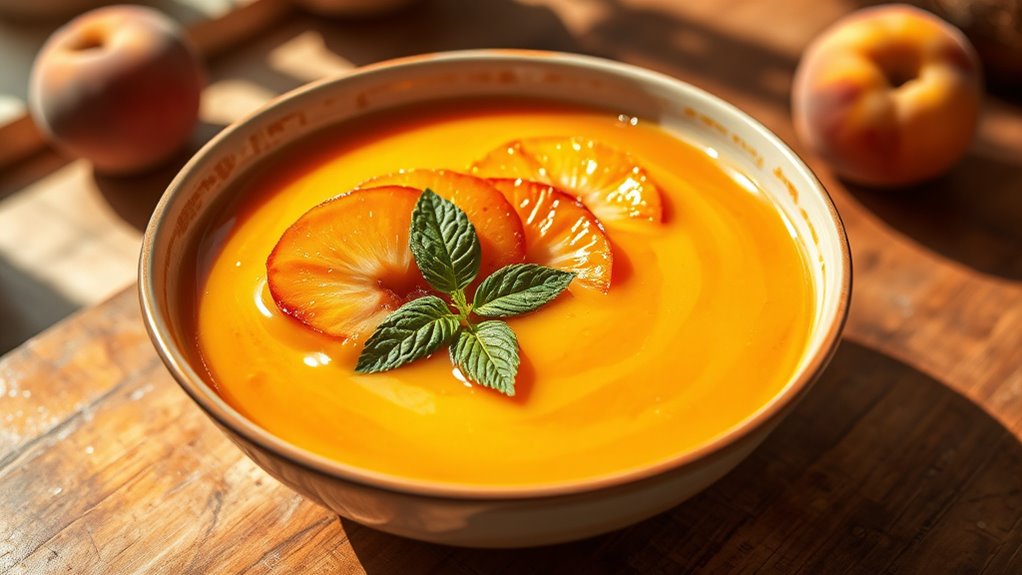To make a bright peach soup, start with ripe peaches and 2 cups of liquid, then blend after simmering gently to release aroma. Use 4 cups sliced peaches, 2–3 tablespoons sweetener, 1 tablespoon lemon juice, and a pinch of salt for balance. Rinse, pit, and puree, adjusting sweetness to taste. Serve chilled in clear bowls with thin peach slices or mint garnish, perhaps a dollop of yogurt. If you keep going, you’ll discover more tips and variations.
Ingredients and Quantity
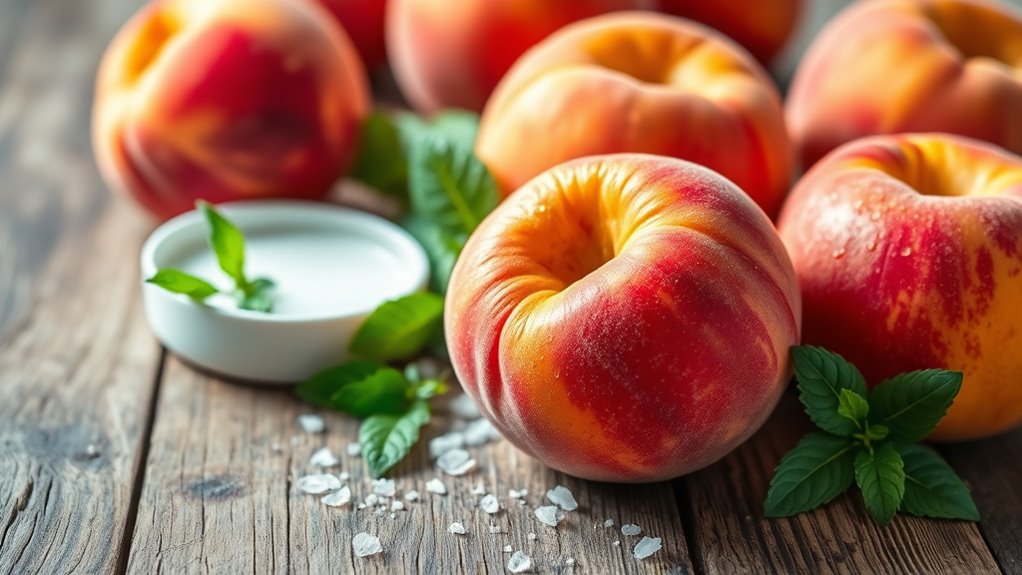
Peach soup typically comes together with a concise set of ingredients: ripe peaches, sugar or honey to sweeten, lemon juice for brightness, water or broth for the base, and a pinch of salt. You’ll choose peach varieties based on flavor and texture, noting seasonal availability to time purchases. Measurements are straightforward: 4 cups sliced peaches, 2–3 tablespoons honey or sugar, 1 tablespoon lemon juice, 2 cups water or light broth, and a pinch of salt. Table for rhythm:
| Item | Quantity | Purpose |
|---|---|---|
| Peaches | 4 cups | Sweetness and body |
| Sweetener | 2–3 tbsp | Balance acidity |
| Liquid | 2 cups | Base and clarity |
This keeps ingredients precise, adaptable, and respectful of your freedom to adjust. Seasonal options influence color and aroma.
Preparations
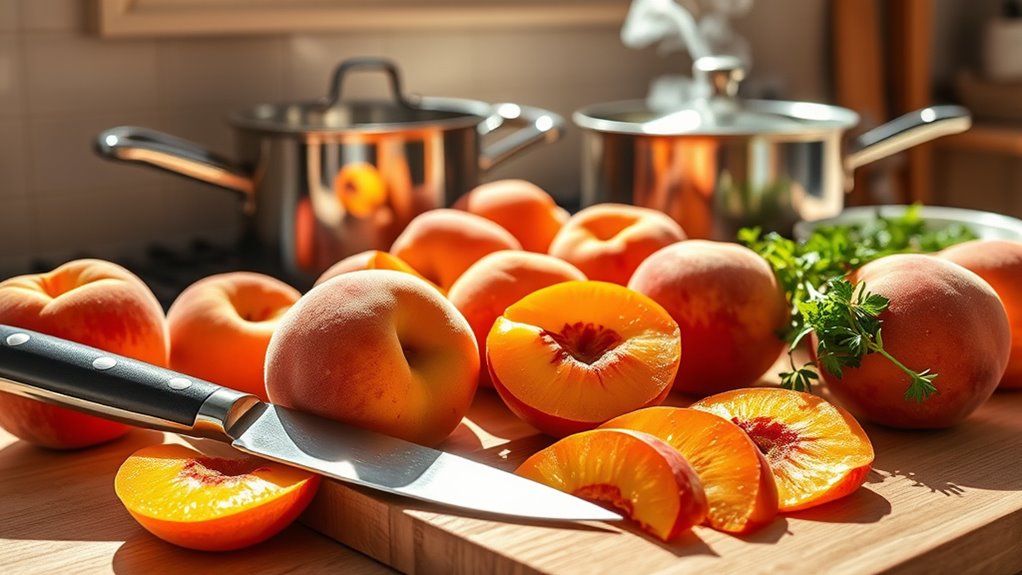
To begin preparations, rinse the peaches under cool water and pat them dry. You’ll focus on straightforward steps that guarantee consistency and reproducibility. Start with preparation methods that minimize waste and maximize flavor, trimming any blemishes and pitting if needed. Keep the fruit uniform in size to guarantee even cooking and texture. Consider ingredient selection as you choose ripe, fragrant peaches with a balanced sweetness. Document your choices briefly so the method can be replicated, noting any variations in ripeness or batch size. Maintain clean hands and surfaces to prevent contamination, and measure juice or puree portions carefully to support precise timing. Record any adjustments for acidity or sweetness, so future preparations remain consistent and accessible for a broad audience seeking reliable results.
Kitchen tools or Kitchenware Required
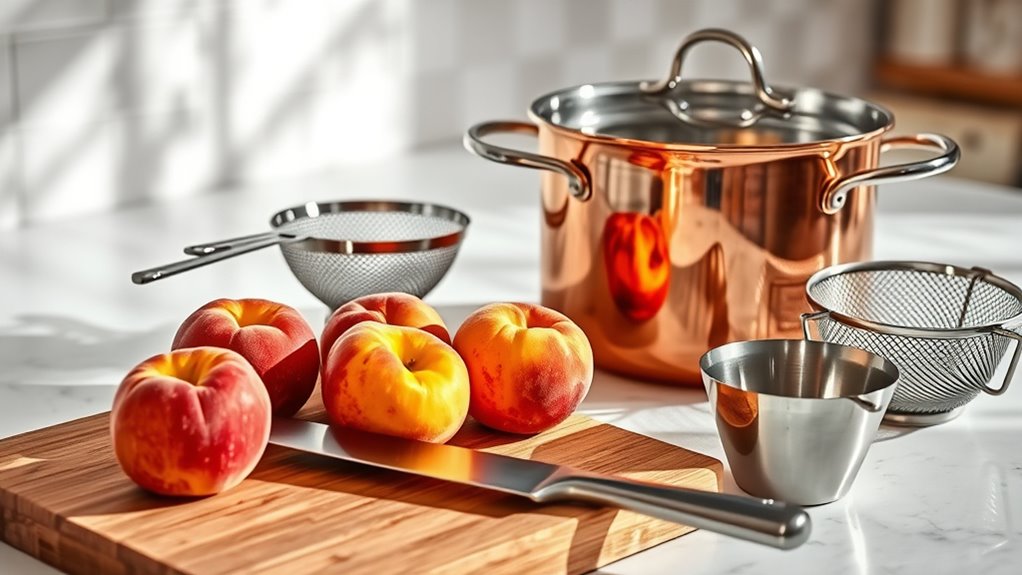
After prepping the peaches, you’ll need reliable tools to handle them efficiently. Choose essential kitchenware that’s durable, easy to clean, and suited to fruit work. A sharp knife, a cutting board, and a vegetable peeler reduce prep time, while a sturdy colander drains juice and pulp. For blending, select blender types that balance power and quiet operation, with a container that resists staining. A measuring cup guarantees accuracy for sweetness and acidity. Transfer to serving bowls that present the soup cleanly. Tableware should be neutral and stackable for efficiency.
| Tool | Purpose |
|---|---|
| Knife | Peeling and slicing |
| Blender types | Pureeing the fruit base |
| Serving bowls | Presentation and portioning |
| Peeler | Skin removal |
| Colander | Draining and rinsing |
How to Cook
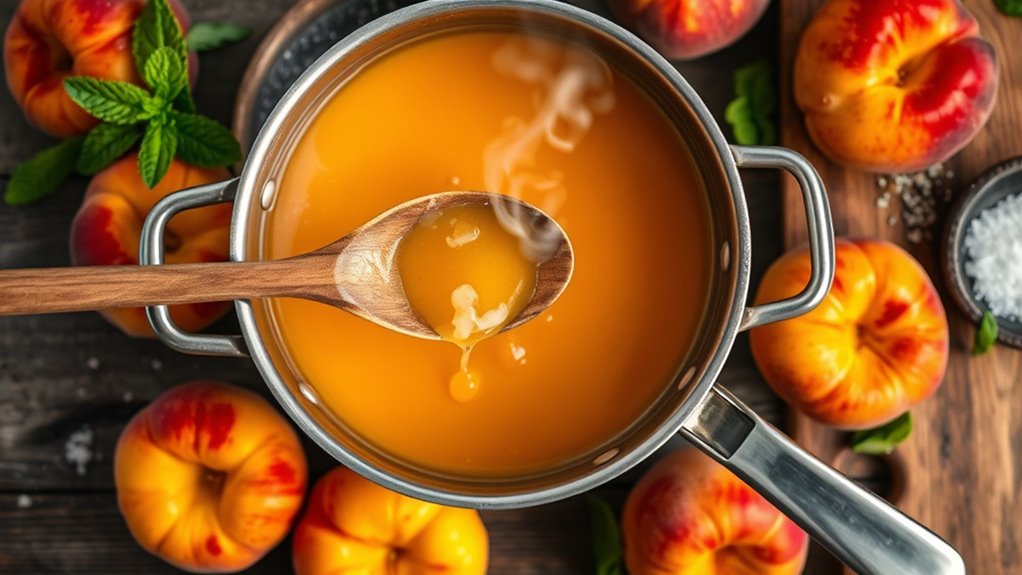
- Gently heat peaches to release their aroma and sweetness.
- Adjust sweetness by adding a touch of sugar or honey as needed to balance natural tang.
- Maintain a gentle simmer, carefully controlling heat to prevent scorching.
- Monitor texture and use precise timing to extract flavor without overcooking.
- Preserve bright peach notes while blending in subtle accents for depth.
- Measure ingredients accurately and observe aromas throughout the cooking process.
- Taste progress regularly to ensure balanced flavor development.
- Emphasize flavor combinations that enhance sweetness with acidity or spice.
- Blend the mixture for smoothness and maintain a crisp, repeatable method.
- Focus on balance, consistency, and aroma to create a smooth, inviting soup.
- Use this peach base as a flexible foundation for further experimentation.
How to Serve
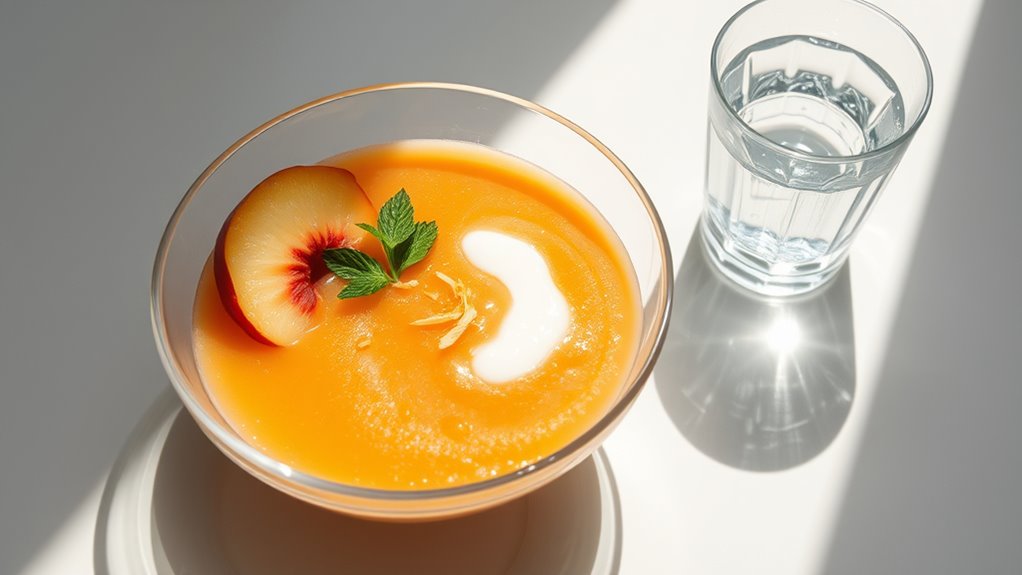
Peach soup is best served at the right temperature and with careful garnishes that enhance aroma. You present it chilled or lightly cooled, depending on your preference, ensuring a smooth consistency. Begin with a clear bowl to showcase its pale, peachy hue and delicate texture. For garnishing options, choose simple accents that complement sweetness without overpowering it: a thin peach slice, a mint sprig, or a whisper of lemon zest. Consider a tiny dollop of yogurt or ricotta for contrast, if you desire creaminess. Serving suggestions emphasize balance: pair with a crisp white wine, a sparkling water, or a mild tea on the side. Keep portions modest and plate cleanly to maintain an uncluttered, inviting presentation.
Tips
To keep peach soup smooth and vibrant, start with ripe fruit and strain well if you blend it. In this Tips section, you’ll find practical moves to preserve clarity, balance, and aroma without overcomplicating the process. Focus on small adjustments that yield clear flavor enhancements and reliable serving suggestions, so you can tailor each bowl to your preferences. Keep your technique steady, measurements precise, and taste as you go.
- Use chilled bowls and spoons to maintain temperature and brightness
- Add a pinch of salt or a light acid (lemon juice) to heighten peach notes
- Finish with a delicate herb or spice drizzle for aroma and contrast
Food Value and Benefit
Peach soup is a light, nutrient-dense dish that provides hydration and a modest energy boost with minimal calories. It contains natural sugars, dietary fiber, vitamins, and minerals that support daily activity without heaviness.
Key vitamins and minerals in peach soup:
- Vitamin C: supports collagen maintenance and provides antioxidant protection
- Potassium: aids nerve function and helps maintain fluid balance
Benefits of eating peach soup:
- Promotes hydration, especially beneficial in warm weather
- Provides a gentle mood lift from fruity flavors
- Supports digestive health and satiety due to its fiber content
- Easily digestible with low fat content
- Offers a balanced energy boost without excess calories
- Suitable for active lifestyles and mindful eating habits
Peach soup can be enjoyed as a revitalizing starter or a hydrating snack, supporting sustainable and freedom-oriented food choices.
Frequently Asked Questions
Can I Substitute Peaches With Nectarines in This Soup?
Yes, you can substitute nectarines. Nectarine flavor remains sunny, though Texture differences may appear, so adjust sweetness and thickeners slightly. You’ll notice a lighter finish, yet still pleasant, keeping your adventurous palate satisfied and prepared for more nectarines.
Is This Soup Suitable for Freezing Afternoons?
Yes, this soup can be stored for freezing afternoons, but note texture may thicken; for best results, consider thawing slowly and whisking to restore smooth soup texture. Freezing tips: use airtight containers and label date.
What Dairy-Free Options Work Best Here?
Sure—dairy-free options that work best are coconut milk and almond yogurt. You’ll want coconut milk for creaminess and almond yogurt for tang. You’ll find these choices enable smooth texture, balanced sweetness, and a bright, freedom-loving finish.
Can I Make This Recipe Vegan-Friendly?
Yes—you can make it vegan-friendly. Use vegan ingredients like almond yogurt or coconut cream, and substitute dairy with plant-based milks. For flavor variations, try mango or basil. This approach stays objective, precise, and accessible for freedom-seeking cooks.
How Long Does It Keep in the Fridge After Serving?
Peach soup lasts 3–4 days in the fridge. Think of it like a careful pantry plan; use peach preservation methods and Soup storage tips, refrigerating promptly, keeping it covered, and rechecking aroma and texture before serving. Enjoy freely.
